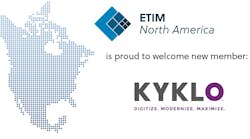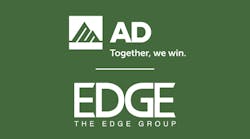Electricians creating labor-saving devices on the job site find themselves in the role of product manufacturer.
New and improved electrical products and tools promising to "save time," "be faster" and "install easier" roll out by the dozens each month. But with today's shortage of electrical workers and strong construction economy, some contractors and electricians can't wait for manufacturers to respond to their needs. Instead, they're developing time- and labor-saving devices in the job-site trenches. Coworkers or employees applaud the devices and urge the inventors to take the products to market. Those innovators with a strong entrepreneurial spirit begin the journey through patenting, start-up costs, manufacturing, marketing and the like. To successfully make the journey, inventors agree the recipe calls for lot of hard work mixed with a little bit of luck.
Brothers Thomas and Joseph Shaffer revel in their good fortune developing the Mud Plug, which protects electrical boxes during drywall installation. "Joe and I will be sitting having dinner and we'll say, 'Can you believe how things have fallen into place here?'" says Thomas Shaffer. "It's almost eerie. Whenever we needed to have something happen, it happened without us actually going out and searching for it."
For instance, while spending time at a lake over a holiday weekend, they ran into Randy Humphrey, a design engineer and mold maker. They were researching plastic injection molding at the time. "We talked with him a little bit about what would be the best way and what kind of plastic," says Shaffer. Humphrey ended up testing six different types of plastic for the brothers and was such an integral to the product's development he was made a partner.
When looking for a company to do the injection molding, Shaffer talked and corresponded with as many as 10 different injection molders across the country. "Low and behold - the least expensive was right here in the Springs, and they were only about two miles from us," says Shaffer. MoldRite Products, Inc., Colorado Springs, Colo., makes the Mud Plugs. Shaffer appreciates the convenience of having MoldRite so close. "If we need to change anything or we want to do a test, I can spin in there anytime. I don't have to go across the country or have things shipped to me."
The idea of the mud plug wasn't a lightning-strike inspiration. With two other brothers who are licensed electricians and their father who is a master electrician, developing the idea for the Mud Plug was a family affair. "It's always been something that we've talked about, and we decided to go ahead and file a patent application on it," says Shaffer.
The simple pressure-fitted device covers electrical boxes, protecting them from routers, joint compound and other perils of drywall installation and new-construction finishing. The Mud Plug is available for both residential and commercial single-gang and double-gang installations. It eliminates the need to clean or repair an electrical box.
The two brothers founded Shaffer Development and Distribution Inc., Colorado Springs, Colo., about a year ago and have patents or patents pending on several electrical products. Shaffer said they decided to develop the Mud Plug first because it was the easiest to produce and the most inexpensive. "We don't have the deep pockets like (big manufacturers)," says Shaffer.
Still, Shaffer says they've invested well over $100,000 in the Mud Plug. The products are made with injection molding, and Shaffer said each mold cost anywhere from $15,000 to $28,000 a piece. Shaffer says the financial challenges have been their biggest obstacle, but he says that is changing. "Now that the product is getting into electrical supply houses, I'm not concerned about the cash-flow situation."
Certainly, getting products into distributorships can be an obstacle. "It's really hard for the little guy to get out there," says Doyle Elder, inventor of the Wire Wagon, which got its start in October 1998. Elder, an Arapaho, Okla., electrician of 22 years, saw a need for a product that would make wire handling easier around the job site. Elder built a few prototypes and eventually came up with the Wire Wagon, a portable workbench/wire dispenser/conduit cart. After taking it to job sites and getting a good response from his co-workers, he made a few minor adjustments and sold two to the contractor he was working for at the time. Then, in Oklahoma City, he sold four more to contractors in less than three hours. "Within a couple of weeks, I quit my job and went into business," says Elder.
Since then he's been busy manufacturing and marketing his product. "Starting out we had absolutely zero name recognition, and we've been building that slowly." By targeting electrical contractors through mailings, advertising in CEE News and Electrical Contractor magazines and exhibiting at trade shows, Elder says the product is beginning to get some name recognition. The Wire Wagon won one of 25 Show Stopper awards at the NECA show last fall and is beginning to be picked up by distributors.
"There's so much we've had to learn. We've just taken it one step at a time," says Elder. Rather than learn by trial and error, Elder has sought advice whenever possible from those in the know. He says Oklahoma's Small Business Development Authority gave him leads and was especially helpful when it came to navigating through legal procedures like patenting. He expects to get a patent this month for the Wire Wagon. An "acquaintance of an acquaintance who was a safety engineer" helped him by analyzing the product and the manufacturing process.
To manufacture the Wire Wagon, which comes in two models, Elder rents space in a facility in nearby Weatherford, Okla. "We were real lucky to be able to rent a space in a manufacturing facility," says Elder. "We were able to use a lot of tools that they already had." He says his small work force is kept busy meeting orders.
Brian Ray is also busy meeting orders for his Li'l Tugger cable puller, which is now marketed by Greenlee Textron. Ray, an electrical contractor of 18 years, came up with the idea out of frustration over tying up five workers while doing a 300-ft cable pull at an Arizona service station. For small- and medium-sized jobs, such as pulling 300-ft runs of bundles of #10 AWG, #12 AWG or #14 AWG wire through 3/4 in. conduit, the cable puller can finish the job in minutes.
"We were on a job and we had three guys pulling on the cable and two guys feeding it," said Ray, the owner of Ray Practical Technologies, Ltd., Mesa, Ariz. "I said, 'This is ridiculous,' and went down to the truck and grabbed a drill and an 18-in. drill bit, and then slid a piece of PVC over the top of it. The bell end of the PVC fit right over the chuck of the drill. I cut off a piece of the PVC, drilled three little holes where it fit into the hole of the chuck, and wrapped a rope around that piece of PVC. It worked great."
Ray then designed a frame that would hold the drill and provide easy access to an on/off switch. He bought $50 worth of parts at a Home Depot and built a working prototype. "It was a real rough prototype, but it worked," he said. "I talked with different people and they said, 'We have to get this marketed.' So, I went to a machine shop and had a prototype built. Once I did that, I rounded up some investors. I figured I needed to get this on the market." Ray applied for patents for the device and got several investors to pool about $100,000 to begin manufacturing the Li'l Tugger. One of his first big breaks was convincing the president of Edson Electric Supply, Inc., Phoenix, Ariz., to stock the pullers in his five Phoenix area branches. He also got Crescent Electric Supply to stock the device in its Tempe, Ariz., branch.
Then, through a contact made at Crescent Electric Supply, Ray was able to take the product national. Paul Maloney, a regional salesperson from Greenlee Textron, Inc., Rockford, Ill., saw the Li'l Tugger and told Ray to give Ken Hagemeyer, director, product management, a call. Hagemeyer found the product intriguing. "When we heard about it, I immediately recognized the void that it filled and that it made sense," recalls Hagemeyer.
After signing a disclosure statement with Greenlee, Ray sent Hagemeyer a video of the product. Hours after watching the video, Hagemeyer invited Ray to Greenlee headquarters to hammer out an arrangement for Greenlee to market the Li'l Tugger. In May 1999, Greenlee renamed the product the Li'l Tugger and launched it through its distribution network. Ray in now manufacturing the product for Greenlee at a machine shop in Arizona.
Ray's success story marketing his product with the help of a big manufacturer isn't all that unique. Contractors and electricians often seek manufacturers to market, produce and/or distribute their products.
"We have a lot of contractors that come to us with ideas," says Tom Stark, president, Arlington Industries, Inc. The Scranton, Pa., manufacturer of metallic and nonmetallic fittings and connectors has introduced more than 300 products since 1990. Some of those products came from contractor ideas. "We're much more able - with our distribution base and the reps we have in place - to take the product to market than a one-product company," says Stark.
Stark says he's also seen a lot of electricians' product ideas that would never get off the ground for one reason or another. He's seen electricians spend money to patent ideas that they'll never be able to do anything with. "One of the things I've found is many times the idea is a good idea if the product could be manufactured at a reasonable cost," says Stark. "But their lack of knowledge about manufacturing makes it such that the idea is extremely costly (to manufacture) and prohibitive from that standpoint." Another potential problem is UL-listing requirements. Stark has seen plenty of ideas that are good until looking at the applicable requirements for UL listing. The idea is simply not listable; therefore it's not marketable.
Still, Arlington values input from contractors and is always on the lookout for new product ideas and ways to improve existing products - maybe even more than in the past because of the shortage of labor. According to Stark, some of their biggest new-product winners lower labor cost, are easier to install and cost less. But he also says that with a little bit of effort on the part of the distributor, higher-costing labor-saving products can be sold, too. "Electrical contractors are looking at time and labor-saving areas much more strongly than they used to because of the shortage of people," says Stark. "If contractors can't add additional people to their staffs, they can grow their sales by finding a way to get more work done with the same number of people. It's made contractors more open to trying things."
Trying new Arlington product prototypes is nothing new for electricians that frequent trade shows. "We go to as many trade shows as we can to get out in front of contractors and see what they like and don't like," says Stark. "That's where a lot of the ideas come from. We're showing them the latest version of a product, and they'll tell you what they like about it and what they don't like about it. A lot of that is fuel to take onto the next step and improve it further."
Jim Dollins, vice president, product development, AFC Cable Systems, New Bedford, Mass., agrees that the best new product ideas often come from the contractor. "As with most of our product development here, we take credit for it, but our customers are really the people who develop our products," says Dollins. "We're just very good listeners."
The idea for AFC's armored fiber-optic cable came from listening to contractors. Dollins said that as a lot of electrical contractors got into the datacom business they found that one of the common applications was to install plenum rated innerduct as a raceway and then pull the fiber-optic cable into that.
From their experience using AFC's MC cable, which comes prewired with conductors already in it and replaces the pipe-and-wire installation method (where you have to install the pipe and then you pull the wires into the pipe), contractors wondered if AFC could do the same with fiber-optic cable. With AFC's MC cable, contractors install it in one step instead of two. "Typically labor is about half the time," says Dollins. "As a result of that, as contractors got into the datacom business, they said to us, 'Boy, we put this fiber-optic cable into plenum-rated innerduct. Do you think you might be able to manufacture an armoured fiber-optic cable that would replace the combination of plenum-rated innerduct and pulling fiber cable in?' So, we went to work on it."
For Dollins, listening for ideas like the one above means a lot of time in the field at trade shows, calling on contractors and consulting engineers. AFC also has a product development committee made up of consulting engineers, electrical contractors, electrical distributors, inspectors, etc. "They listen to our ideas and what we've heard from the field and they give us advice on whether we're doing something smart or dumb," says Dollins. "Or they give us advice on how to make our dumb things smart."
Making dumb things smart. That's what it's all about when it comes to developing and launching electrical products. That, and a little luck.
By just concentrating on marketing products, the electrical distributor dangerously identifies itself with commodities and gives control of its marketing destiny to manufacturers. We believe wholesalers should control and manage their proprietary value of service; marketing fee-based services is a good place to start.
Although some electrical distributors find the idea of charging for services difficult, we believe it's imperative. In the first two parts of this series we've explored the preparatory skills needed for a company to develop and launch new services. In last month's installment, we explored the first few steps in the New Service Development (NSD) process: idea generation, concept development and testing. For this final installment, let's look at Financial Assessment, Communications Strategy, and Market Testing of a new service.
Business and Financial Assessment. Few people make good financial decisions relying on intuition alone. This is absolutely applicable to the service development cycle. The key to making quality conclusions about whether or not to proceed with launching a new service is to have a good estimate of cash flow. You must build an effective baseline model that adequately accounts for the economics of a new service. But first, why is it important to value the service in financial terms?
Intangible assets are often clearly more valuable than tangible assets. However, on the balance sheet, Generally Accepted Accounting Principles (GAAP) limit companies from separating out intangibles; any and all value from intangibles is lumped into a single number: goodwill. As a result, valuing services from a financial standpoint has been largely ignored. Managing their associated risks also has been largely ignored. If services are not perceived to be genuine assets, a company risks committing inadequate resources to their launch and plowback for upkeep. Indeed, a lack of appreciation for intangibles can lead to missed opportunities and to missteps in the marketplace.
So how can you measure services? Historic cost, replacement value, market value, premium price and royalty relief are available methods. Although all these methods are applicable, the economic-use approach is superior in function and design. Economic-use is a straightforward method requiring first the estimate of future cash flows and then the discount of those flows back to the present. Comparing the net present value of a service under different assumptions provides a good indication of the impact of the proposed service.
Hard vs. Soft Returns. Every good model is designed to answer one question. "Should we invest in the service?" The answer is determined by the proposed service's returns. Every potential project will have both hard and soft returns to account for. Hard returns are the ones explicitly represented in the model. They are quantifiable in financial terms and have traceable impact in the short term. These are captured in numeric terms through diminished costs or revenue enhancements. Soft returns are not so easily quantifiable. Returns such as customer satisfaction, risk reduction or relationship enhancement are of great consequence to the income statement; therefore, they must be addressed by the analysis but only after building a quantitative case.
Creating the Base Case Model: Accounting for Hard Returns. With new service development, the cornerstone of analysis is intuitive - not factual. The accuracy of the outcome relies on the critical assumptions made during the process. If the model is too elaborate there is more room for error because of the large number and intricacy of assumptions. Conversely, if the model is too simple, it may not permit a realistic modeling of financial outcomes. A balanced model that uses measurable variables and is reasonably simple with straightforward assumptions is the most feasible alternative. The more reliable the assumptions, the more reliable the model.
The next few paragraphs describe what is in the model, as represented by Figure 1.
Estimating Sales. The first line of the model refers to a projection of revenue expected over five years. The assumption is that billing for the service occurs as a line item rather than blending the cost into an overall project quote. It's sometimes helpful to project sales in year one and extrapolate that number forward by some percentage. The percent change can be either variable or fixed depending on the most probable outcome. Estimating sales requires some pretty enlightened assumptions. Pricing, of course, is the most obvious. In the end, the price will reflect the value added to the customer from the service rather than a cost plus method. However, it may be helpful to rough out the costs of providing the service prior to fixing the charge. Top line sales revenue reflects the sales of the service only. Additional products sold as a result of offering the service are represented in the supplementary contribution numbers.
Cost of Goods Sold. The second row of the model contains all expenses of the proposed sales during the five-year period. Estimate the value of labor and materials used to produce the service to generate these numbers.
Gross Margin. It is now possible to calculate a gross margin for the service. The gross margin is simply line one minus two (sales minus cost of goods sold).
Development Costs. Development costs include all expenditures consumed in the process of service development. Be sure to include all the expenses incurred thus far, like idea generation and screening, and concept/positioning development and testing. Additional upcoming expenses such as those related to communications development, market testing and commercialization must be accounted for as well.
Marketing Costs. Line 5 highlights related post-launch marketing. Over the five-year horizon, the marketing budget would increase at rates that parallel sales revenue (i.e. year one = 15%, year two = 25%, years three to five = 11%). Marketing dollars would continue to provide the level of support for the new delivery service that any new product would receive upon rollout and through its early life cycle.
Allocated Overhead. Every product or service contributes to administrative costs. In a wholesale distributor business, these would involve general operating expenses such as staff salaries, utilities, insurance, interest, bonuses, etc. A general allocation for activities that only indirectly generate revenue is depicted in line 6 of the model.
Gross Contribution. Gross contribution is calculated in much the same way that gross margin was: subtract line items 4, 5, 6, (development costs, marketing costs and overhead) from line 3 (gross margin).
Supplementary Contribution. The new service will generate increases or decreases in the sale of other products or services.
Net Contribution. Line 10 accentuates the net contribution. In our model, the net contribution is the summation of Gross Contribution resulting from the service and Supplementary Contribution resulting from additional product sales.
Cumulative discounted cash flow. In order to ascertain the present value of the contribution, discounting is necessary. Using a 10% rate, discount cash flows (DCF) for each year and calculate the total five-year value of the service in today's dollars. This is the number that counts because management often bases the go/no-go decisions on it. If you are unsure about the math, consult with your accountant on using DCF modeling for project returns.
Valuing Soft Returns. Now that the hard returns are accounted for, the impact of the soft side can be addressed. Soft returns either amplify or counterbalance hard returns. Nonfinancial "scoring" systems incorporate assessments of the service's impact on the overall value package perceived by the customer.
Valuing the soft side plays an important role in pricing strategy for a new service. How do customers value the service? The economic value procedure estimates the dollar value of any quantifiable savings the customer may benefit from by subscribing to the service. Another positive soft return is a highly satisfied customer. Sophisticated management information systems can quantify these impacts precisely. Identifying customer metrics like customer acquisition cost and profitability per relationship makes quantifying soft returns precise and reliable.
Promotion: Telling and Selling. Developing a strategy to communicate your service to the market ignites the marketing planning process. Promotion is all about communicating information from distributor to customer. The objective is to effect attitudes and buying behavior. The business of promotion is nothing more than making the customer aware that a desirable service is available in a favored place at an attractive price. Figure 2 lays out some of the foundation building decisions that will affect the destiny of the service.
To Name or Not to Name. Often the name issue is an extension of hubris; obviously the wrong reason to name a service. There is, however, at least one very valid reason to label your new service with a name all its own. Naming is an easy way to communicate what the service itself is and position the service in the minds of potential users. The name can become the focal point of all the benefits and features that relate to the service.
Often firms will elect to service mark or trademark a selected name in order to protect the position of their service in the marketplace. Choosing a name that is "owned" by a competitor can be an embarrassing - not to mention costly - ordeal. Selecting a trademark attorney, who can check the free and clear use of a name, is a smart investment for several hundred dollars.
The Message: Getting the Word Out. The newly developed service is in its life cycle infancy. During this stage, the objective of promotion is to inform. If the service is truly a new idea, rather than an innovation or adoption, the promotion campaign must build initial demand. In economics, this is called "primary demand means meeting a base need." Next, identify the target audience.
Copy: The most important element of any print media ad is the headline. More people read the headline than the actual body copy. The two most powerful words to use in a headline are "New" and "Free." What would a world-class salesperson say to elicit an instant sale? Draft an answer to that question on paper, and you've written an ad that will sell.
Market Testing. Before rolling out a new service company-wide, there is one more crucial step: the pilot. Skipping this step could prove to be a costly mistake. Testing a service prior to launch is as much an opportunity to gather intelligence as it is to plot future success. Every aspect of a service can be scrutinized during this period. The objective is to hone the service and all its accompanying promotional material. The market test provides opportunity to learn about everything from the receptivity of the concept to the effectiveness of the supporting campaign to whether or not the pricing is on target. The more information you can garner, the more successful the rollout and the long-term prospects of your new service.
Auditing the Process. Much like accountants auditing financial statements, a marketing audit can be done at the end of any development process, particularly one that focuses on a service. The purpose is to identify what worked and what didn't. It functions rather like an autopsy and can be a very powerful tool to transfer knowledge gained through the process. The audit can reveal those elements that need to be modified before the service is actually rolled out. This "debugging" period is an opportunity to modify the components of the marketing mix. In addition, critical insights from the sales force can be amassed.
The Downside. The negative side to running a pilot is cost. Implementing a new service for testing is roughly as expensive as commercialization because most of the costs are in the infrastructure (developing the process capability). Although variable costs like a scaled down promotional phase are less than a full launch, the bulk of service costs are in preparing for launch. So why go through the headache and expense of testing a service before rolling it out? The rationale is the same as for conducting a dress rehearsal in theater: it identifies problems and areas working well but with limited downside risk.
Often wholesalers will attempt to develop the perfect product before launching. In performing an audit of the test rollout, managers become over zealous in fixing problems. This syndrome is common in manufacturing product development and is cause for frequent missed launches, over- expenditures and missed marketing opportunities. "Roughly right" is a good rule of thumb to follow. As long as the service works to the standard of your other service offerings, it's time to launch it. Spending months on small, infrequent obstacles doesn't make financial sense, and the customer often doesn't care about the details that concern managers.
The Go/No-Go Decision. The goal of a test market, like the goal for all steps in the service development process, is to produce a quality go/no-go decision. Only a market-driven company can sustain an even balance between enthusiasm for a new service and objectivity to read what the research really says. It's much easier to determine that a service is not a good idea in the idea generation or concept development stage. It's quite another matter to "can" an idea that has been carefully hatched for sixth months or more. But remember, sacred cows are generally those most ripe for slaughter. If the test pilot meets satisfaction, quality and financial objectives, launch the service accompanied with other elements of the marketing mix.
This installment ends the four-part series on fee-based services. We hope you have a better appreciation for the complexity and necessity of offering services for commerce. Selecting, developing, and marketing services should be as natural as marketing the products, but this isn't usually the case. As we see it, the primary and controllable value addeds of distribution are the services distributors provide.








